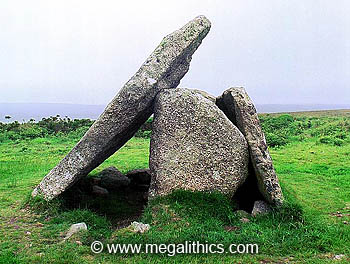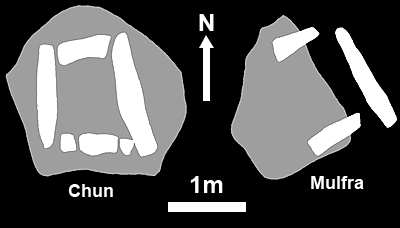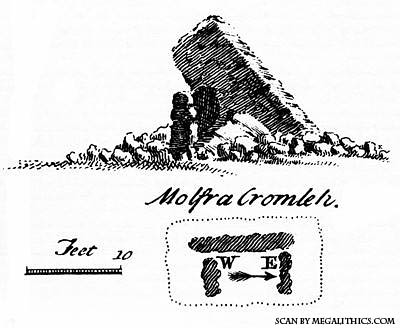
 |
|
Photo Gallery |
|
|
VR Panoramas |
|
| SW 45190 35368 (GPS 35min) | |
| Visited June 2000 | No magnetic anomalies |
The Mulfra Quoit stands near the summit of
Mulfra Hill, and on a day with better visibility than the one of our visit,
probably has spectacular views over the surrounding countryside. Some of the
stones that formed the burial chamber are missing, so it is difficult to get
an idea of its original form. The two possibilities seem to be either a four slab
stone box with capstone as at Chun Quoit, or a Portal Tomb arrangement having a
second set of side slabs to the SW sealed with a "entrance" slab.
When a plan of the Mulfra Quoit is compared to that for the Chun Quoit (see
below), it is obvious that the simple addition to Mulfra of another side slab at
the SW would create a structure very much like that of the Chun which stands
only 5km away to the WSW.

We noticed that the underside of the capstone at Mulfra has a centre section that is raised by several
centimetres. If the capstone were to be tilted to rest on the surviving slabs,
it looked as though this raised section would fit between the side slabs and
engage on the top of the NE slab. Whether this feature is worked or
natural, it would have served to stabilise the structure of the chamber and lock
the capstone in place.
William Borlase (1) published the engraving and plan of Mulfra shown below in 1769, it is worth comparing the extent of the remaining cairn material shown in the illustration with our photos of the Quoit. Borlase writes, "The Stone-Barrow with which this Cromleh is surrounded is about two feet high from the general surface, and 37 feet three inches in diameter." As can be seem from our photos, nothing of this substantial mound remains today.

Borlase gives the original size of the
capstone as nine feet eight inches by fourteen feet three inches, this included
"a piece evidently clove, or broke off from it , and lying near it".
The capstone fragment was not in evidence during our visit and has probably
shared the fate of the cairn material that was extant in Borlase's time. Borlase
dug into the ground area enclosed by the stones going down twenty inches until
he hit the "natural, stony stratum which lies on the Karn, not moved since
the deluge". He found various layers of coloured earth which led him to
believe that a pit had originally been dug in the interior.
W.C.Borlase, writing over a hundred years later (2), largely repeats his
forebear's account of the Quoit and dispels a report "by the author of the
Land's End District" that the Mulfra Quoit was felled by a lightning strike
during a thunderstorm in 1752. Borlase states that his forebear visited the
Quoit on the 23rd of October 1749, and "at that time the Cromlech was in
precisely the same state as present."
W.C.Borlase describes how in the winter of 1871 he investigated "a low
cairn of stones, about thirty feet in diameter, and two feet high, on the
northern brow of the hill on which this Cromlech stands", the only finds
being charred wood and a smooth pebble. Another cairn lying to the west was
checked but was found " to have been previously overhauled."
Later authors treat Mulfra as very much the poor relation of the Cornish Quoits,
Hencken (3) dismisses it along with Chun as "nothing but an enormous cist
in a round barrow". Daniel (4), although including a plan drawing of Mulfra
in his survey of Chamber Tombs, scarcely mentions more than the name of the
Quoit, classifying it as a "typically rectangular" chamber.
1. Borlase W. Antiquities Historical and
Monumental of the County of Cornwall, Bowyer and Nichols, London 1769
2. Borlase W.C., Naenia Cornubiae, 1872 Longmans.
3. Hencken H., The Archaeology of Cornwall and Scilly, 1932 Metheun.
4. Daniel G.E., The Prehistoric Chamber Tombs of England and Wales, 1950
Cambridge University Press.